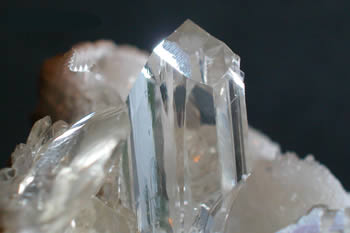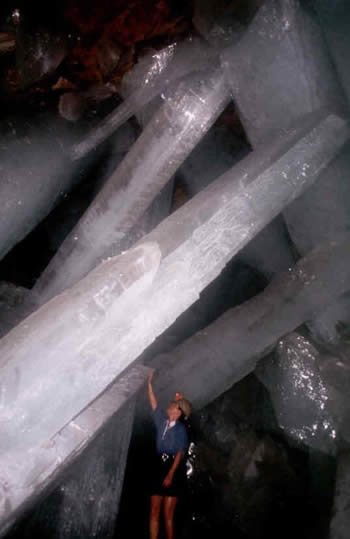Your Details
Your Details
|
Reviewed By Andreas Zabczyk
Selenite Gemstones
Transparent Selenite Crystal
The term selenite is used to refer to varieties of the mineral gypsum that show obvious crystalline structure. Selenite is used to refer specifically to transparent and colorless gypsum, but sometimes it is used to refer to all the different crystalline varieties of gypsum, including satin spar, desert rose and gypsum flower. Gypsum is composed of hydrated calcium sulfate and it is a very soft mineral, with a rating of only 2 on the Mohs scale. It is so soft that it can be scratched by a fingernail. It is also quite a light material with a density of only 2.20 to 2.40, which is in roughly the same range as opal. Gypsum has insulating properties, so a crystal of gypsum will feel warm to the touch. Diamond, by contrast, is an excellent conductor, so it will feel cold if you touch it to your lip. 
Selenite Megacrystals in Mexico
Gypsum crystals can grow to remarkably large sizes. Some enormous crystals have been found in the caves of the Naica Mine in Chihuahua, Mexico, that measure more than 11 meters in length. The name selenite comes from the Greek for "moon", since the vitreous to pearly luster of selenite exudes a glow that is reminiscent of the moon. Selenite is typically transparent and colorless, though some selenite crystals show translucency or color due to inclusions of other minerals such as druse, copper, silver, sulfur or iron. Where selenite is usually transparent, satin spar is silky, fibrous and translucent with a pearly or milky appearance. Desert rose is rosette shaped gypsum with an outer druse of sand or with sand throughout; it is typically dusty rose, reddish or brown in color. Gypsum flower is rosette shaped with spreading fibers. Where desert rose looks like a rose, gypsum flower forms a wide range of shapes. Of the four varieties of crystalline gypsum, the transparent selenite is the rarest. Gypsum is the most common of the sulfate minerals and is found in every continent. By far the most famous source for selenite is the Naica Mine in Mexico. The Cave of the Crystals contains giant selenite crystals that are among the largest natural crystals of any kind that have ever been found. |
